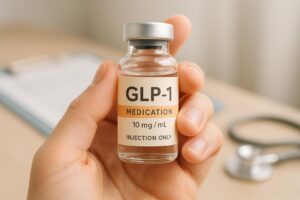Which GLP-1 Has the Least Side Effects?

The world of weight management and diabetes treatment has witnessed a significant revolution with the introduction of glucagon-like peptide-1 (GLP-1) receptor agonists. These medications, designed to mimic the functions of a naturally occurring hormone, have become pivotal in managing blood sugar levels and promoting weight loss. However, as with any medication, there is an inevitable concern regarding side effects. Today, we will explore the various GLP-1 medications on the market, focusing on which GLP-1 has the least side effects and how they can best support your health journey.
Introduction
Did you know that nearly 42% of American adults are classified as obese? This alarming statistic highlights the growing public health challenge related to weight management and metabolic disorders. The emergence of GLP-1 receptor agonists like semaglutide and liraglutide has opened up new avenues for effective treatment, providing a glimmer of hope for many struggling with obesity and type 2 diabetes.
At TrimRx, we understand that embarking on a weight loss journey can be daunting, especially when considering medication. That’s why we are committed to providing personalized, medically supervised care tailored to your unique needs. In this blog post, we aim to provide clarity on the different GLP-1 medications available, discuss their side effects, and pinpoint which option may have the least adverse reactions.
By the end of this article, you will gain insights into the benefits and drawbacks of various GLP-1 medications, helping you make an informed decision about your weight management or diabetes treatment plan. We will also touch upon our personalized programs at TrimRx, designed to offer comprehensive support throughout your health journey.
Understanding GLP-1 Receptor Agonists
GLP-1 receptor agonists are a class of medications primarily used to treat type 2 diabetes and, more recently, obesity. These drugs work by mimicking the action of the GLP-1 hormone, which is naturally secreted by the intestines in response to food intake. The physiological functions of GLP-1 include:
- Stimulating Insulin Secretion: In response to elevated blood sugar levels, GLP-1 promotes insulin release from the pancreas.
- Suppressing Glucagon Release: This results in decreased glucose production by the liver.
- Slowing Gastric Emptying: This mechanism promotes a feeling of fullness and reduces appetite.
- Enhancing Satiety: GLP-1 acts on brain regions responsible for hunger, helping to curb cravings.
Given their multifaceted roles, GLP-1 receptor agonists have shown effectiveness not only in lowering blood sugar levels but also in facilitating weight loss, making them an attractive option for patients with obesity.
Current GLP-1 Medications
As of today, several GLP-1 receptor agonists have received FDA approval, including:
- Semaglutide (Ozempic, Wegovy, Rybelsus)
- Liraglutide (Victoza, Saxenda)
- Dulaglutide (Trulicity)
- Exenatide (Byetta, Bydureon)
- Tirzepatide (Mounjaro, Zepbound)
- Lixisenatide (Adlyxin)
Each of these medications has unique characteristics, dosing regimens, and side effect profiles.
Side Effects of GLP-1 Receptor Agonists
While GLP-1 receptor agonists offer numerous benefits, they are not without potential side effects. Understanding these effects is crucial for individuals considering these medications. The most common side effects associated with GLP-1 receptor agonists include:
- Gastrointestinal Issues: Nausea, vomiting, diarrhea, and constipation are the most frequently reported side effects. These symptoms are typically dose-dependent and may be more pronounced during the initial stages of treatment.
- Injection Site Reactions: Some individuals may experience redness, swelling, or itching at the site of injection.
- Pancreatitis: Although rare, there is a potential risk of developing pancreatitis, which necessitates immediate medical attention.
- Kidney Issues: In some cases, GLP-1 receptor agonists may contribute to kidney impairment, particularly among individuals with pre-existing conditions.
Which GLP-1 Has the Least Side Effects?
To determine which GLP-1 medication may have the least side effects, we can look at comparative studies and clinical trials. Research indicates that different GLP-1 receptor agonists exhibit varying tolerability profiles.
Recent meta-analyses suggest that:
- Dulaglutide has been associated with the lowest incidence of gastrointestinal side effects compared to other GLP-1s, making it a favorable option for those concerned about potential digestive issues.
- Exenatide (Bydureon) has also shown a lower risk of gastrointestinal symptoms, particularly in its extended-release formulation.
- Semaglutide and Liraglutide, while effective, tend to produce a higher frequency of gastrointestinal side effects, especially at higher doses.
Understanding these nuances can help patients choose a GLP-1 that matches their treatment goals and tolerability.
The Role of TrimRx in Your Weight Loss Journey
At TrimRx, we believe in a holistic approach to weight management. Our personalized weight loss programs incorporate the latest advancements in telehealth technology, ensuring you receive tailored support every step of the way.
Our offerings include:
Personalized Weight Loss Program
To access our personalized weight loss medications, individuals must complete a free assessment quiz. This quiz helps us identify your specific needs, allowing us to create a customized treatment plan that may include medications like compounded semaglutide, oral semaglutide, or other GLP-1 receptor agonists.
Take our free assessment quiz today to see if you qualify for personalized weight loss medications.
Quick-Access Supplements
In addition to prescription medications, we offer quick-access supplements designed for immediate purchase to support your overall wellness. These include:
- GLP-1 Daily Support: A supplement formulated to complement your weight loss efforts.
- Weight Loss Boost: Designed to provide an additional edge in your weight management journey.
Find out more about our quick-access supplements and how they can support your weight loss goals:
Managing Side Effects Effectively
For individuals considering GLP-1 receptor agonists, it’s important to manage potential side effects proactively. Here are a few strategies to help mitigate gastrointestinal symptoms:
- Start with a Low Dose: Gradual titration of dosage can help your body adjust to the medication, minimizing digestive upset.
- Stay Hydrated: Ensure adequate fluid intake, especially if experiencing diarrhea or vomiting.
- Eat Smaller, More Frequent Meals: This approach can help reduce the feeling of fullness and lessen gastrointestinal discomfort.
- Communicate with Your Healthcare Provider: Regular check-ins can help address any concerns and adjust treatment as necessary.
Conclusion
In the landscape of weight management and type 2 diabetes treatment, GLP-1 receptor agonists have emerged as powerful tools. While they offer significant benefits in regulating blood sugar levels and promoting weight loss, understanding their side effect profiles is crucial for making informed decisions.
Among the available options, Dulaglutide stands out as having the least gastrointestinal side effects, making it a potentially favorable choice for many patients. However, individual experiences may vary, and it is essential to work closely with a healthcare provider to determine the best medication for your needs.
At TrimRx, we are dedicated to providing personalized weight loss solutions that align with your health goals. By taking our free assessment quiz, you can start your journey towards a healthier lifestyle today.
FAQ
What are GLP-1 receptor agonists used for?
GLP-1 receptor agonists are primarily used to manage type 2 diabetes and, more recently, to aid in weight loss for individuals with obesity.
What are common side effects of GLP-1 medications?
Common side effects include gastrointestinal issues such as nausea, vomiting, diarrhea, and constipation, as well as injection site reactions.
Which GLP-1 medication is best for me?
The best GLP-1 medication for you will depend on various factors, including your medical history, current health status, and any previous medication experiences. Consult with your healthcare provider for personalized recommendations.
How can I manage side effects while on GLP-1 medications?
Managing side effects can involve starting with a low dose, staying hydrated, eating smaller meals, and maintaining open communication with your healthcare provider.
How can TrimRx help with my weight loss journey?
TrimRx offers personalized weight loss programs and quick-access supplements designed to support your goals. By taking our free assessment quiz, you can discover the best options for your individual needs.

Transforming Lives, One Step at a Time
Keep reading
Tracking Progress With GLP-1: What To Measure
Learn which metrics to track on GLP‑1 therapy—weight, waist, blood sugar, lipids, side effects, and non‑scale wins—and how often to monitor them.
Fatigue Solutions for Ozempic and Wegovy Users
Hydration, protein-rich meals, light activity, and better sleep can reduce medication-related fatigue and help maintain energy during weight-loss treatment.
GLP-1 Medication Side Effect Checker
Worried about GLP-1 medication side effects? Use our free checker for Semaglutide, Liraglutide, and more to learn what to expect and stay informed!



